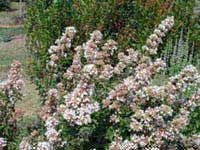Resource Library
Plant of the Week: Chinese Abelia
The University of Arkansas System Division of Agriculture does not promote, support or recommend plants featured in "Plant of the Week." Please consult your local Extension office for plants suitable for your region.
Plant of the Week
Chinese Abelia
Latin: Abelia chinensis

Butterfly gardening has become a big hit with gardeners, who are always looking for plants to attract these beauties into the garden. One of the best for this purpose is the many-flowered Chinese Abelia, Abelia chinensis.
This shrub reaches 6 to 8 feet tall with multitudinous branches sticking out in all directions, like Phyllis Diller on a bad-hair-day. It produces long, wispy growth covered with maroon-tinged leaves with a predictable triangularity as they cluster along the arching stems.
As the summer wears on, plants produce massive terminal clusters of white, bell- shaped flowers. Butterflies are especially fond of the flower. As long as the plant continues to make new growth during the summer, it will continue to flower.
Because the plant branches so freely, it often suffers mightily at the hands of well-intending gardeners who shape it into round-topped balls that often take on the profile of a giant mushroom.
Chinese Abelia, unlike its better known progeny Glossy Abelia, flowers from midsummer until fall but has a much higher bloom count when it does flower. While the Chinese Abelia is never covered with a mass of flowers like an azalea, its persistence of bloom keeps it from receding into the background, especially when cloaked with butterflies.
Abelia is named after Clarke Abel (1780-1826), who was a surgeon and naturalist on the second unsuccessful British embassy to China in 1816. The embassy was attempting to obtain more favorable trading privileges for the English East India Company, which they finally accomplished by the Opium Wars 20 years later.
Abel collected specimens and seeds of the plant, later named Abelia chinensis in his honor, while he and the embassy were being politely but firmly ushered out of the country along the Grand Canal. On his return voyage, the ship struck an uncharted reef, and the party found itself shipwrecked near present day Sumatra in Indonesia. A seaman, acting on the orders of one of the aristocrats on board, dumped Abel’s 300 packets of seed into the sea so that his clothes could be saved.
The day after the wreck, they managed to retrieve some of the plant specimens only to have the small boat they were using attacked and burned by pirates. While Abel returned to England empty handed, he was fortunate enough to have left duplicate specimens of some of the material with an acquaintance in Canton. These duplicate sets were returned to him and used to establish the plant as a new member of the honeysuckle family.
Abel’s Abelia was finally introduced into England as a living plant in 1844 by Robert Fortune. Some time about 1900, a gardener or nurseryman had the inspiration to cross Abelia chinensis with A. uniflora, another Chinese species, and the Glossy Abelia as we know it today was born. Unfortunately, no record remains of who made this cross. When the hybrid was introduced, the species fell from the trade. But, in the past few years, the original species is making its way back into gardens as a prime attractant for butterflies.
Chinese Abelia is an easily grown plant that should be located in bright light, or preferably full sun. Too often, the plant is sheared to make a clipped shrub that looks more like a toadstool than a plant. A better remedy is to remember that the plant grows 6 feet tall and wide, so give it plenty of room.
When it needs pruning to control size, cut it back severely in the spring just before growth begins. It should be pruned about as severely as the forsythia and at about the same time, which is early spring.
By: Gerald Klingaman, retired
Extension Horticulturist - Ornamentals
Extension News - July 2, 2004
The University of Arkansas System Division of Agriculture does not maintain lists of retail outlets where these plants can be purchased. Please check your local nursery or other retail outlets to ask about the availability of these plants for your growing area.